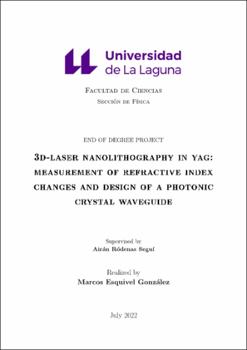3d-laser nanolithography in yag: Measurement of refractive index changes and design of a photonic crystal waveguide
Fecha
2022Resumen
In the present work, a study of photonic structures is carried out simultaneously
from an experimental and computational point of view. Experimentally, the yttrium
aluminium garnet (YAG) optical crystal has been used to study the wet-chemical
etching enhancement in sub-micron width line tracks written with the 3D laser writing
(3DLW) technique. This technique uses a femtosecond pulse laser (∼150 fs) in the NIR
espectral range (∼800 nm). The size of the hollow pores obtained by the wet-etching
in lithographed areas, with widths of sub-micron size and lengths in the sub-mm order,
are ideal for the creation of photonic structures. In this context, it has been possible to
analyse and identify the laser configurations that achieve a higher etching rate in this
crystal depending on scan speed, laser pulse repetition rate, and pulse energy. Also,
the possibility of creating air pores of different diameters or with a circular shape can
be controlled by changing the energy pulses of the laser. On the other hand, by means
of a wavefront phase imaging (WFPI) technique developed at Wooptix S.L., the order
of the refractive index change (10−2) produced at sub-micron scale in YAG due to the
3DLW process has been characterized for the first time. Complementarily, a numerical
study of a 2D nanopore hexagonal photonic lattice in YAG has been performed by
means of commercial software (BandSOLVE, RSoft). Thus, this allows to identify the
configuration with an optimal photonic bandgap, found to be for light propagating
with its electric field lying within the plane. Finally, possible confined modes for a
microstructured optical waveguide (MOW), simply designed with a cladding hexagonal
structure and a single pore defect in the centre as core, have also been investigated. En el presente trabajo se realiza un estudio tanto experimental como computacional
de estructuras fotónicas. En el ´ámbito experimental, se estudia la mejora en el grabado
químico húmedo producida en cristal ´óptico de granate de itrio y aluminio (YAG)
para líneas trazadas con grosor sub-micrométrico mediante la técnica de escritura láser
3D (3DLW). Esta técnica utiliza un láser de pulsos de femtosegundos(∼150 fs) con
longitudes de onda en el rango NIR (∼800 nm). El tamaño de los poros vacíos obtenidos
por el grabado húmedo en zonas litografiadas, con anchuras de tamaño sub-micrométrico
y longitudes inferiores al milímetro, son ideales para la creación de estructuras fotónicas.
En este contexto, se ha podido analizar e identificar las configuraciones láser que
consiguen una mayor tasa de grabado en YAG en función de la velocidad de barrido,
la tasa de repetición de los pulsos láser y la energía de los pulsos. Asimismo, la
posibilidad de crear poros de aire a diferentes diámetros o con forma circular se ha
podido controlar cambiando la energía de pulso del láser. Por otro lado, gracias a una
técnica de medición de frente de onda (WFPI) desarrollada en Wooptix S.L., se ha podido
caracterizar por primera vez el orden del cambio de ´índice de refracción (10−2) producido
a escala sub-micrométrica en YAG debido al proceso 3DLW. Complementariamente, se
ha realizado un análisis numérico de una red fotónica hexagonal de nanoporos 2D en
YAG mediante software comercial (BandSOLVE, RSoft). De esta manera, se consigue
identificar la configuración con un bandgap fotónico (PBG) ´optimo, encontrado para
la luz que se propaga con su campo eléctrico dentro del plano. Finalmente, se han
investigado los posibles modos confinados para una guía de onda microestructurada
MOW, simplemente diseñada con una estructura hexagonal de revestimiento y un ´único
defecto de poro en el centro como núcleo.




